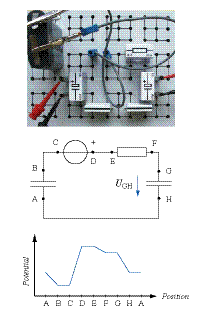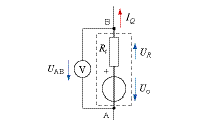3. Systems Analysis II: Potentials and Voltages | | 
| | Electric potentials takes the role of electric levels. Potential differences are level differences which we consider to be the causes for electric processes. Alternatively, we may look at processes leading to potential differences. Remember that a (negative) potential difference is called a voltage. Potential differences (voltages) in closed electric circuits. The potential changes from point to point in a closed electric circuit. To make use of this observation, choose a few important points in the system such as the circuit of Figure 1. Label potential differences (voltages) from point to point by arrows and by symbols UAB, etc. (Figure 1). We can draw a diagram looking like a “landscape” (Figure 1). When we are back at the origin, the potential is the same. Therefore, the sum of all voltages in a closed circuit must be equal to zero (loop rule, Kirchhoff’s Second Law): Processes in an element. Real devices such as resistors, batteries, capacitors, or cables have several properties (a battery produces heat in addition to setting up a driving voltage, and a wire can also have so-called inductive properties, Chapter 5). We introduce two or more voltages making up the one that is measured across a device: It is important to distinguish between the voltage across a device exhibiting more than one process, and the voltages associated with each process in a model of the device (Figure 2). The latter cannot be separated and measured independently. There is no “pure engine” inside a battery setting up the voltage U_o coupled to a “pure” resistor across which we have a voltage U_R. The elements identified in the model do not exist independently. |

Figure 1

Figure 2
| | |

